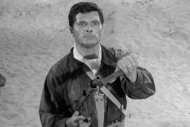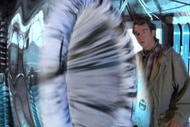Create a free profile to get unlimited access to exclusive videos, sweepstakes, and more!
How Jackie Chan became an animated superstar 20 years ago with Jackie Chan Adventures

By the year 2000, Jackie Chan had seemingly done it all: starring in, writing, and directing multiple Hong Kong action classics, releasing a handful of multi-platinum albums, and accomplishing a long-term goal of crossing over to the United States thanks to his performance in 1998’s Rush Hour. So what was next for the superstar? Why, becoming a cartoon character, of course.
On this date 20 years ago, Jackie Chan Adventures, the first series to feature the name and likeness of the legendary stuntman, premiered on Kids' WB. The series followed an animated version of Chan (voiced by James Sie), an archaeologist living in San Francisco who traveled the world on Indiana Jones-esque adventures, searching for and acquiring ancient artifacts after being recruited by a top-secret organization called Section 13. Chan goes up against everything from criminal syndicates to demons to dark wizards with the help of his crotchety uncle named Uncle (Sab Shimono), his plucky 12-year-old niece Jade (Stacie Chan), and a handful of eccentric associates.
How the Fearless Hyena made the transition from the silver screen to Saturday mornings began as many stories in Hollywood do: with a phone call.
Sony Television was in the market for a new action-adventure series that could appeal to younger and older kids, as well as boys and girls. Andy Kaplan, former vice president of Sony Pictures Television, noticing the buzz Rush Hour was generating around Hollywood, was confident that Chan could give the company exactly what it was looking for. “Jackie’s audience is far and wide,” Kaplan told SYFY WIRE over email, “so I thought if we could create a fun show that highlighted Jackie’s multi-layered talents, maybe we’d have something special.”
He called up Sony Television’s head of Family Entertainment at the time, Sander Schwartz, and posed a question: “How about we do an animated series starring Jackie Chan?” Schwartz told SYFY WIRE in a phone interview that after listening to his boss’s idea, he responded with a question of his own: “What’s the series?” Over 20 years later, Schwartz still remembers the response he got from Kaplan: “Well, you’re the head of animation, you figure it out.”
Schwartz was never one to walk away from a challenge, but he did have some reservations. “Usually, when you grow and develop a series, whether it's based on a movie, a television show, or a book, I have some idea of what the show is," Schwartz says. He didn’t really know anything when it came to Chan, because, as he says, “Jackie was really in the early stages of his career in the U.S.” His concerns were not completely unwarranted; while Chan was no stranger to animation, having done voice work on the Chinese release of Beauty and the Beast and Mulan, this would be an entirely different endeavor. It would place him in front of an audience who had little to no connection to him, many of whom were too young to have seen him trade one-liners with Chris Tucker in theaters, let alone go kick-for-kick with the likes of Benny "The Jet" Urquidez on video.
What saved the series and how it came to be was due to a number of people who were not only familiar with Chan’s oeuvre pre-Rush Hour, but more than happy to share their passion with a younger generation.
The first was screenwriter, comedian, and the person credited with creating what would become known as Jackie Chan Adventures, John Rogers. A massive fan of Hong Kong action cinema, it took the superfan no time at all to figure out the direction a Jackie Chan adventure series should go. Armour of God, Chan’s 1986 feature in which he plays a treasure hunter, served as the ultimate inspiration, Rogers tells SYFY WIRE. “He goes on adventures, chasing artifacts; all we had to do was figure out a way to make it kid-friendly,” he says.
Rogers wrote a short pitch that included the basic plot and many of the characters we would see in Adventures: the three Chans, Captain Black, Section 13, the Black Hand, and Tohru, an enforcer who switches sides after Season 1. Sony quickly approved it and brought on writers and producers Jeff Kline and Duane Capizzi — both admirers of Chan’s career — to develop the series. Capizzi, who would serve as story editor and co-executive producer on Adventures, was also hesitant about bringing Chan to animation, but not for the same reasons as Schwartz. Capizzi was worried that the series might water down what makes Chan’s films so special, the physicality and stunt work, and he also didn’t want to end up performing what could have been a disservice to an actor whose career he clearly admired. “I loved Jackie's movies so much, I didn't want to make the bad Saturday morning cartoon version and ruin that for everybody,” Capizzi says.
Believing that something was missing — one final ingredient to make the entire recipe work — Capizzi took Rogers’ pitch home. There he figured out that what the series needed was a magical element, finding inspiration in one of his favorite films, 1987’s A Chinese Ghost Story, a romantic-comedy horror film directed by Ching Siu-tung that mixes traditional Chinese wuxia action set pieces with early Sam Raimi supernatural horror, and touches of exaggerated comedy. By combining magical Hong Kong cinema with the action-comedy of Jackie Chan, Capizzi says, “I kind of sneakily mixed together my two favorite things.”
With Capizzi now firmly on board, Sony met with a number of networks to pitch its new series. It was not a surefire sell, even with Chan performing stunts during pitch meetings. The series found a home on Kids’ WB, which had recently become the No. 1 kids' programming block thanks to Pokémon being added to the lineup in early 1999. Former Vice President of Kids’ WB Donna Friedman Meir told SYFY WIRE that once Pokémon became a hit, “my job was to build a schedule around Pokémon,” recalling something that her boss, former President of the WB Jamie Kellner once told her, “that basically, I had been handed the equivalent of Friends at 8 o'clock on Thursday night,” she says.
Kids’ WB was confident that Adventures could hold its ground, with Kline remembering former exec John F. Hardman telling them right away, “I got this. I love this. I want this. I’m gonna make this happen.”
To help the audience become more connected with Chan once the adventure of the week was completed, Sony had the idea of a live-action segment where Chan would answer questions, perform moves, and explain aspects of Chinese history and mythology. “Jackie took to it right away,” Schwartz says. “I think it helped make the show more relatable to kids, and it let them connect more closely to Jackie the artist.” The segments were filmed by Kline, who shot them in a style that recalled The Monkees, the 1973 live-action series starring the band of the same name, a childhood favorite. “At the end of every episode, they used to do a live-action Q&A with Davey, Mickey, Mike, and Peter, and I used to love that part,” Kline says. “It was a way of seeing them off-script, just being themselves, so it grew out of what The Monkees did, so that we could give the audience more Jackie.”
Premiering on the fifth anniversary of Kids’ WB, the show’s first season, in which Chan and his team would search for The Talismans of Shendu — a dozen mystical stones all possessing a specific power and engraved with a member of the Chinese zodiac — was an instant success. It quickly became the No. 2 rated show in the lineup; the network ordered a second season a month after the premiere. It was a crowning moment for everyone involved, especially Rogers, who was advised by his agency at the time not to take the job because “there’s no money in animation.” The success of the first season allowed Rogers to purchase his first home. “It was a very important lesson for me,” he says. “Always do what you want to do.”
The subsequent four seasons would focus on another collection of artifacts that Chan and his team would search for. The talismans (whose inspiration Kline says he got from a Chinese menu during a lunch meeting he had with Capizzi) would appear throughout the series and be the only item that Chan and his team would hunt for in more than one season. “Kids' WB could not get enough of the talismans,” Capizzi says. "When we went into Season 2, [the Demon Portals Arc], [Kids' WB] were like, ‘We want more talismans,’ and we're like, ‘You gotta be joking — we just did that.'” But the talismans were ultimately the focus of the third season, with their energy scattered to select “noble animals” after Jackie tries to destroy them with a laser.
The more magic-focused plots would continue down the line, with subsequent seasons focusing on demon portals, which could be located with the Pan’Ku Box (a mystical puzzle box), the Oni Masks, which were created by Japanese wizards and imprisoned a gang of demon generals, and finally the Demon Chi, evil energy that can transform a human into a demon.
Jackie Chan Adventures ran for a total of 93 episodes, airing in over 60 countries, with numerous episodes referencing Chan’s long career as a Hong Kong action star either visually or in the episode’s title. It spawned a series of books and comics, as well as a pair of video games: Jackie Chan Adventures: Legend of the Dark Hand for the Game Boy Advance and Jackie Chan Adventures for the PlayStation 2. In 2017, Chan announced a new CG series, All New Jackie Chan Adventures, that had nothing to do with the original series. Meir says that during her tenure at Kids’ WB, Adventures was “one of the shows that I was most proud of”; to this day, when asked, Schwartz says that “among all the shows and I've worked on in my time, and often I’m asked which am I most proud of, there's a handful, one of them being Jackie Chan Adventures.”
Jackie Chan Adventures succeeded and helped Chan reach even more success in the U.S. two decades ago because everyone who worked on the show, from the executives to the writers to the star himself, had a clear vision of what the show should be. It was a fun, lighthearted, and entertaining series that not only paid ample tribute to the career of cinema’s greatest martial arts movie star but was proof that Chan’s mixture of charm and fearless acrobatics could succeed with a younger generation, in both the second and third dimension, all without Chan having to break a sweat.



























